
The Chinese knew about Taiwan island yet in 3 century
A.D, but the first settlements there appeared only in the first
quarter of 17 century, when famine struck the nearest province of
China and the governors gave a spur to migration of the starving
people to the island. Before that Taiwan was a base for Chinese
and Japanese pirates. In 1590 the Portuguese who were first in Europe
to visit the island named it Ilha Formosa (meaning "Beautiful island"),
and that time they tried to settle there but without much success.
In 1624 the Dutch occupied the southern part of the island and in
1626 the Spaniard took the northern one. By 1646 the Dutch got control
over the whole island but in 1661 they were forced out by the supporters
of the the Ming dynasty. In 1683 Taiwan became a part of the Ching
dynasty. By that time the population of the island amounted to 200,000
people. It was occupied primarily by the Chinese from the south-eastern
part of the country. In 1842 there were 2.5 million people. In 1858
it was agreed upon admittance of Spanish and Dutch ships into the
country's ports. In 1874 Japanese dragooned there to protect fishermen
of Ryukyu island. In 1884 - 1885 during the French-Chinese War the
island was occupied for a short time by french forces.
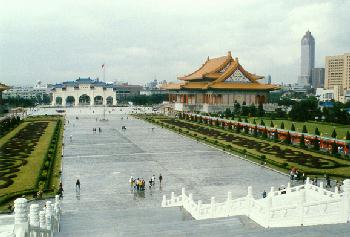
In 1886 Taiwan became a separate region of China,
and in 1894 Taipei became an official center of the province. In
1895 after the Japanese-Chinese war Taiwan and Pescador Islands
were given to Japan. The natives gave a strong resistance to the
occupants but were suppressed. During the Japanese governing the
island started production of rice, developed irrigative and transport
systems. Since 1930s it got an industrial upraising based on production
of cheap hydroelectric power.
As you know, Taiwan is a "motherland" of the most
part of computer components. "Made in Taiwan" is a business card
of a great deal of mainboards, video and sound cards etc. Although
today a lot of firms transfer their production facilities to China,
the Taiwanese industry still dominate. Besides, "Made in China"
make some people doubtful in quality of such products, while "Made
in Taiwan" is a quality assurance.
Beside countless firms whose products are of quite low quality there
are authoritative and solid companies in Taiwan. One of such long-livers
is Leadtek Research. Of course, its history is incomparable with that of
the island itself...
During the World War II Taiwan was a base of incursion
of the Japanese forces into the South-East countries. On October
25, 1945, after the surrender of Japan the island was given to Chinese
government Chiang Kai-shek. When China get involved into the civil
war in 1949-1950 thousands of refugees, officials and military supporters
of the old government moved to the island escaping from the communist
troops. But the army of the communist China concentrated its forces
on the continent and in Tibet, and USA declared protection of the
residents with the 7-th fleet and provided help to Taiwan. In 1954
the United States and Taiwan concluded an agreement. Outside, up
to 1970s young states of Asia and Africa, with the USA's firm position,
considered Taiwan as a legal government of China. However, since
1969 The United States started making steps toward liberalization
of relationship with China and in 1971, on agreement of Washington,
Taiwan was forced out from U.N.O., and its place was taken by CPP.

In 1979 the USA restored the diplomatic relations
with China and broke them off with Taiwan. However, the military
and economical support wasn't put off. In 1987-1988 the political
life of the island changed: the martial law brought in in 1949 was
canceled, a free election of the President was held, and small contacts
with China started again. When the confrontation of the two systems
ceased in 1990s the foreign policy of Taiwan improved to some degree.
Right since the end of 80s / beginning of 90s of
the last century Leadtek started its development. I guess Leadtek
stands for Leader of Technology, though I might be wrong.
Apart from well-known video cards the company produces a good deal of
mainboards, sound cards, multimedia systems and video phones. I must say
that some time ago Leadtek dealt mainly in production of professional solutions
based on processors from 3DLabs and other companies. But 4 years aLready
it has been producing gaming video cards. All this time the company has
been using only NVIDIA chipsets and it is one of the main partners of this
Californian corporation. That is why Leadtek is always among first to release
new powerful solutions on processors of the last generation. It also concerns
GeForce4 Ti. Well, the slogan "We Make Dreams a Reality" is not
meaningless words. And now we turn to the card in question and, first of
all, I'd like to give you the links to the previous articles on the new
family.
Theoretical materials and reviews of video cards which concern functional
properties of the NVIDIA GeForce4 Ti GPU
While GeForce4 MX440 cards have already glutted the market, Ti 4400/4600
ones are just entering it. And today we are going to examine a production
card based on the most powerful 3D accelerator - GeForce4 Ti 4600.
Card
The Leadtek WinFast A250Ultra TD has an AGP x2/x4 interface,
128 MBytes DDR SDRAM located in 8 chips on both sides of the PCB.
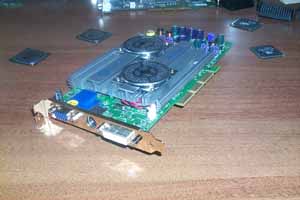
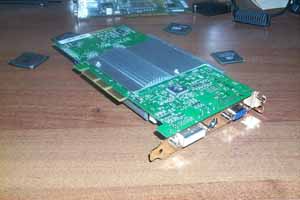
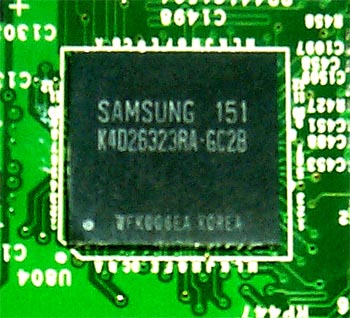
The memory chips are produced by Samsung with the 2.8 ns access time
which corresponds to 357 (714) MHz. The card works at 325 (650) MHz.
As I mentioned earlier, GeForce4 Ti cards uses a new package. The new
package and design allow the card work at its rated frequencies even without
cooling (remember the GeForce4 Ti 4400 and its 3.6ns memory which runs
at the rated speed of 275 MHz). However, the engineers played safe and
reduced the memory frequency by more than 30 MHz. The chip works at the
rated 300 MHz.
Leadtek WinFast A250Ultra TD with an installed cooler
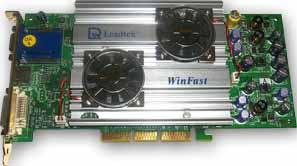
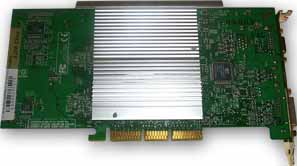
Leadtek WinFast A250Ultra TD without a cooler
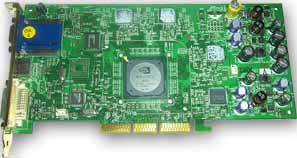
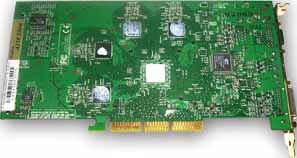
NVIDIA GeForce4 Ti 4600
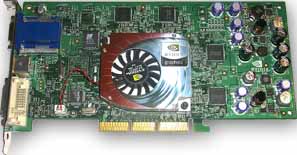

I showed here two photos (with the cooler and without it) so that you can
make sure that the reference-based design was altered for such a huge device.
Let's take a closer look at such an amazing design of the cooler:
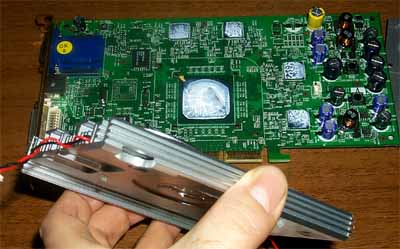
It consists of two heatsinks:
- a big one:
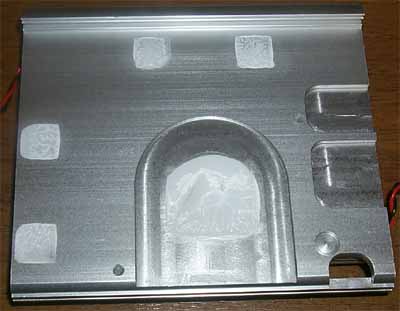
- and a small one:
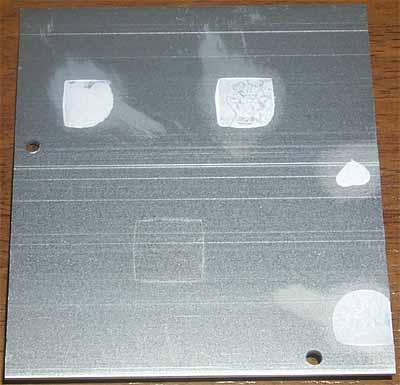

The heatsinks are designed so that they can cool both the GPU and memory
chips. On the rear side of the chip we got a heat-conducting element which
the small heatsink is pressed against:

Now look at the big heatsink:
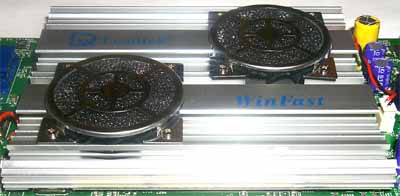
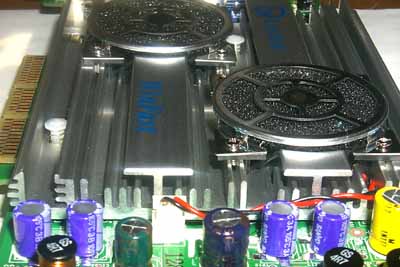
As you can see, there are two fans. Each of them has a dust-protective
grill which touches the blades and, thus, makes more noise. That is why
we had to remove that stuff:
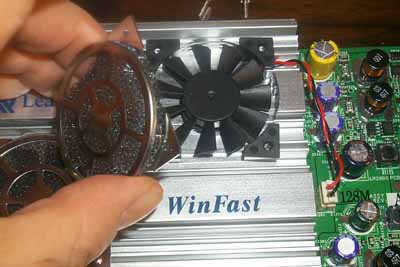
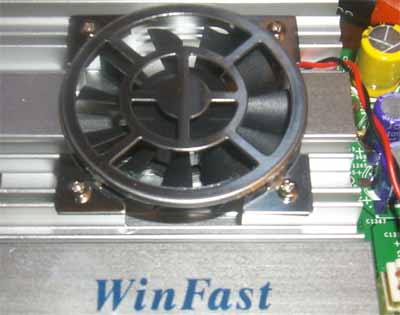
The device is attached with two plastic pins; besides, the big heatsink
is designed so that it can cling to the PCB. However, I doubt that such
weak clips are able to keep a 0.5kg device for a long time.
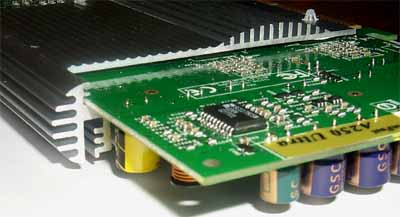
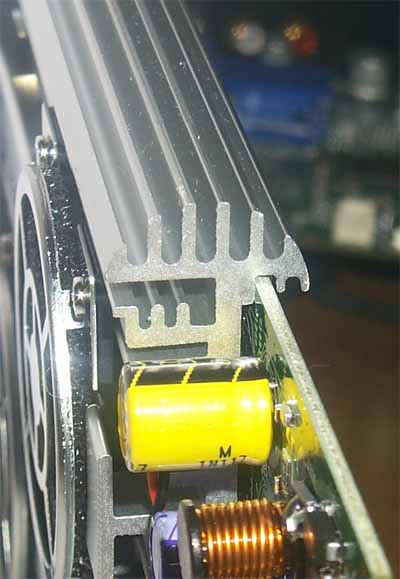
By the way, the experience shows that solid heatsinks are not effective
for cards which heat up much.
Nevertheless, the cooler's design is unique, it has two fans, that is
why we can hope it is reliable.
Under the heatsink we unexpectedly reveal... our most powerful GPU :-)
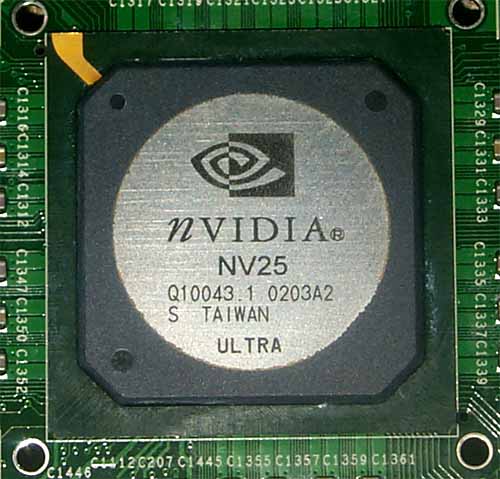
As you can see, the chip is marked as NV25 (the chip was produced on the
third week of 2002, i.e. in January, before the official announcement of
GeForce4).
I must also say that such long video cards with a lot of capacitors
in its tail part can be incompatible with some mainboards, for example,
with EPoX 8KHA+, though it is exactly a mainboard to be blamed.
See the details in the MSI
GF4Ti4600 review.
The Leadtek WinFast A250Ultra TD has three connectors:
VGA, DVI and TV-out; it is also equipped with an external TV
codec from Conexant.
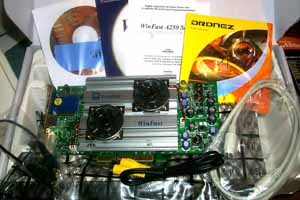
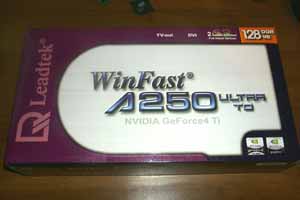
The card ships in a retail package which contains the following stuff:
- User manual;
- 3 CD with software:
- drivers and utilities (and a DVD player from Leadtek);
- DroneZ game;
- Gunlock game;
- S-Video extender;
- S-Video-to-RCA adapter.
Overclocking
Apart from the drivers (v27.20/Win9x and 27.30/WinXP)
the card comes with WinFox utility (we examined it in the Leadtek
WinFast GeForce4 MX 440 review).
The card were able to work stably at 314/375 (750)
MHz.
Note:
- in course of overclocking you must provide additional cooling,
in particular, for the card (first of all, for its memory):

However, in this case the heatsink was able to
cool the card excellently even at such high frequencies.
- overclocking depends on a definite sample, and you shouldn't
generalize the results of one card to all video cards of this
mark or series. The overclocking results are not the obligatory
characteristics of a video card.
Test system and drivers
Testbed:
- Pentium 4 based computer:
- Intel Pentium 4 2200 (L2=512K);
- ASUS P4T-E (i850) mainboard;
- 512 MBytes RDRAM PC800;
- Quantum FB AS HDD, 20 GBytes;
- Windows XP.
The test system was coupled with ViewSonic P810
(21") and ViewSonic P817 (21") monitors.
In the tests we used NVIDIA's drivers of v27.51.
VSync was off, S3TC was off.
For the comparative analyses we used the following
cards:
- Reference card NVIDIA GeForce4 Ti 4600 (300/325 (650) MHz,
128 MBytes);
- ABIT Siluro GF3 Ti500 (NVIDIA GeForce3 Ti 500, 240/250 (500)
MHz, 64 MBytes).
I must note that this card doesn't differ from
the reference
one and MSI
GF4Ti4600 in the performance, that is why I missed some tests
and didn't compare the Ti 4600 with ATI's solutions (the NVIDIA's
monster is anyway above all). Besides, in our 3Digest
the Ti 4600 is paid much attention to. This time I'm going to touch
upon anisotropic filtering once again (in the Vulpine GLMark test).
Test results
However banal it may be, but 2D quality is very
high and corresponds to the reference card's level. You can work
comfortably up to 1600x1200@85 Hz. The dual monitor support of such
cards was examined in this
review.
For estimation of 3D quality we used:
- GLMark (Vulpine) - a synthetic test which demonstrates operation
of the card in OpenGL using capabilities of the GeForce3/4;
GLMark: general testing
The tests were carried out in 32-bit color mode
at the highest detailing and quality level of textures.
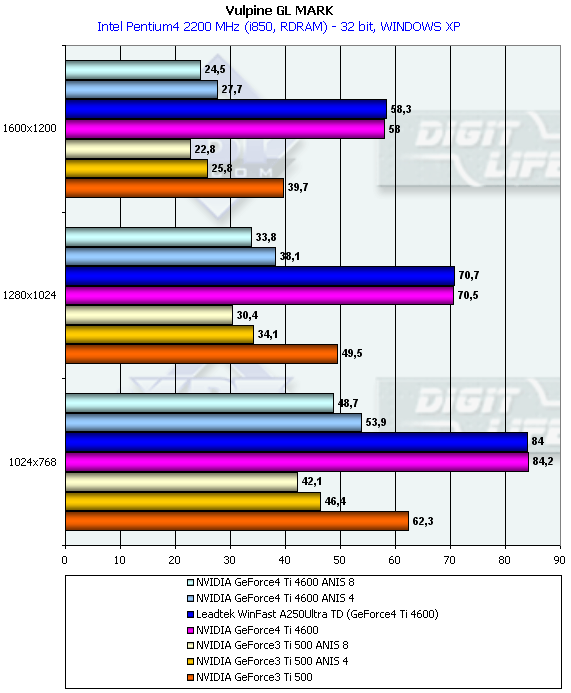
This test was released a year ago to demonstrate
power of 3D monsters of that time - GeForce3 cards. The cards failed
in the tests full of poligons and effects. And now the today's leaders
show decent playability.
The anisotropic filtering still causes a bad performance
decrease, though it is smaller than the Ti 500 had. I think NVIDIA
must take immediate measures because all owners of GeForce3 cards
which understand what is anisotropy do not play without it. And
here... will you pay $400 odd for the same performance as the previous
Ti 500 had (with the anisotropy enabled)?
GLMark: minimal performance values
The tests were carried out in 32-bit color mode
at the highest detailing and quality level of textures.
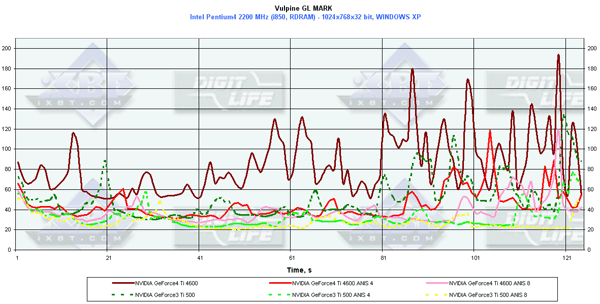
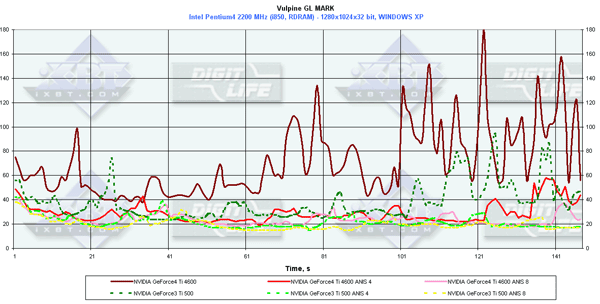
I have no comments as everyone has its own opinion
and sees what he'd like to see, and such concepts as smoothness
are always subjective and indistinct.
In closing I recommend that you read our GeForce4
Ti review. And in our 3Digest
you can find detailed information on performance of such cards on
different platforms.
Conclusion
The first advantage of the card which we just examined
is its weight, it can be a good cold arms:) But this advantage can
turn into a drawback if an AGP slot lacks for a clip and if you
can't fasten the card quickly to a board. On the whole, we have
an excellent card. Its huge cooler didn't cause any overheating,
and the device worked stably at 314/750 MHz without any additional
cooling.
The only that worsens impression is the dust-proof
grills which make noise (though maybe it is the only sample that
has the grills falling off the sticky surface).
Highs:
- Excellent quality of the card;
- Fine performance level in 3D (the highest for today) of the
GeForce4 Ti 4600;
- Full support of all functions from DirectX 8.0 and partial
support of those from DirectX 8.1;
- Effective cooler of the unique design;
- Good retail set.
Lows:

Write a comment below. No registration needed!
